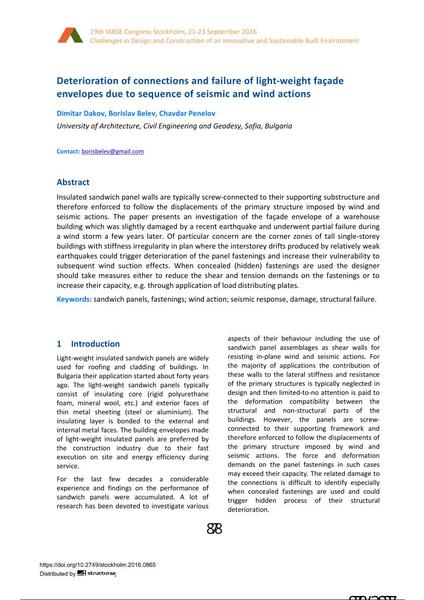Deterioration of connections and failure of light-weight façade envelopes due to sequence of seismic and wind actions

|
|
|||||||||||
Bibliographic Details
| Author(s): |
Dimitar Dakov
(University of Architecture, Civil Engineering and Geodesy, Sofia, Bulgaria)
Borislav Belev (University of Architecture, Civil Engineering and Geodesy, Sofia, Bulgaria) Chavdar Penelov (University of Architecture, Civil Engineering and Geodesy, Sofia, Bulgaria) |
||||
|---|---|---|---|---|---|
| Medium: | conference paper | ||||
| Language(s): | English | ||||
| Conference: | IABSE Congress: Challenges in Design and Construction of an Innovative and Sustainable Built Environment, Stockholm, Sweden, 21-23 September 2016 | ||||
| Published in: | IABSE Congress Stockholm, 2016 | ||||
|
|||||
| Page(s): | 878-883 | ||||
| Total no. of pages: | 6 | ||||
| Year: | 2016 | ||||
| DOI: | 10.2749/stockholm.2016.0865 | ||||
| Abstract: |
Insulated sandwich panel walls are typically screw-connected to their supporting substructure and therefore enforced to follow the displacements of the primary structure imposed by wind and seismic actions. The paper presents an investigation of the façade envelope of a warehouse building which was slightly damaged by a recent earthquake and underwent partial failure during a wind storm a few years later. Of particular concern are the corner zones of tall single-storey buildings with stiffness irregularity in plan where the interstorey drifts produced by relatively weak earthquakes could trigger deterioration of the panel fastenings and increase their vulnerability to subsequent wind suction effects. When concealed (hidden) fastenings are used the designer should take measures either to reduce the shear and tension demands on the fastenings or to increase their capacity, e.g. through application of load distributing plates. |
||||
| Keywords: |
seismic response damage sandwich panels structural failure fastenings wind action
|
||||
